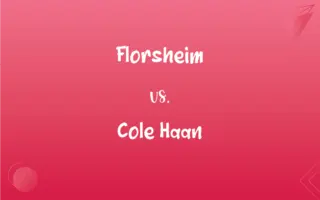BCC vs. FCC: What's the Difference?
Edited by Aimie Carlson || By Janet White || Published on February 7, 2024
BCC (Body-Centered Cubic) and FCC (Face-Centered Cubic) are two types of crystal lattice structures differing in atom arrangement.

Key Differences
BCC (Body-Centered Cubic) is a crystal structure where atoms are located at each corner of a cube and one atom at the body center. In contrast, FCC (Face-Centered Cubic) has atoms at each cube's corners and at the centers of all the cube faces. This fundamental difference in atomic arrangement affects their properties and applications.
In a BCC structure, there is less atom-to-atom contact, with only 8 neighbors touching each atom. FCC structures, however, have 12 equidistant nearest neighbors, providing more atom-to-atom contact. This distinction impacts the density and packing efficiency of the materials.
BCC metals, such as iron at room temperature, typically exhibit lower density and are less ductile compared to FCC metals like aluminum. The reduced density in BCC is due to the less efficient packing of atoms.
FCC structures are generally more ductile and have a higher melting point than BCC structures. This is because the closer packing in FCC structures results in stronger metallic bonds.
In terms of slip systems, which are important in determining how materials deform, FCC structures have a greater number of slip systems compared to BCC. This makes FCC metals more formable and suitable for various industrial applications.
ADVERTISEMENT
Comparison Chart
Atom Arrangement
Atoms at cube corners and center
Atoms at cube corners and face centers
Nearest Neighbors
8 neighbors
12 neighbors
Density
Generally lower
Generally higher
Ductility
Less ductile
More ductile
Melting Point
Generally lower
Generally higher
ADVERTISEMENT
BCC and FCC Definitions
BCC
BCC is a type of unit cell in crystallography with a central atom surrounded by eight corner atoms.
Chromium has a BCC crystal lattice, contributing to its hardness.
FCC
FCC, in metallurgy, describes a crystalline structure with closely packed atoms.
The FCC structure of nickel increases its strength and corrosion resistance.
BCC
BCC refers to a cubic crystal lattice where each corner and the center of the cube has an atom.
Iron crystallizes in a BCC structure at room temperature.
FCC
FCC is a crystal structure commonly observed in metals with high ductility and thermal conductivity.
Silver, with its FCC structure, exhibits high thermal and electrical conductivity.
BCC
BCC, in metallurgy, describes a crystalline structure with less closely packed atoms.
The BCC structure of alpha-iron makes it relatively soft and ductile.
FCC
FCC refers to a crystal lattice where atoms are located at each corner and the center of each face of the cube.
Aluminum exhibits an FCC structure, enhancing its malleability.
BCC
BCC stands for a lattice arrangement contributing to the magnetic properties of certain metals.
The BCC arrangement in iron contributes to its ferromagnetic properties.
FCC
FCC stands for a lattice arrangement that often results in higher ductility and melting points in metals.
Copper's FCC structure contributes to its excellent electrical conductivity.
BCC
BCC is a crystal structure commonly observed in metals at high temperatures.
Tungsten remains in the BCC phase across a wide temperature range.
FCC
FCC is a type of unit cell in crystallography with atoms closely packed at cube corners and face centers.
In gold, the FCC structure imparts high ductility and resistance to corrosion.
BCC
Initialism of blind carbon copy
FCC
(crystallography) face-centered cubic
BCC
Initialism of body-centered cubic
FCC
An independent governmeent agency that regulates interstate and international communications by radio and television and wire and cable and satellite
BCC
To send something by blind carbon copy.
FAQs
How are atoms arranged in an FCC structure?
At each corner of the cube and at the centers of all the cube faces.
What does BCC stand for?
Body-Centered Cubic.
How are atoms arranged in a BCC structure?
At each corner of a cube and one at the body center.
What is a key characteristic of BCC metals?
Generally less ductile and lower density.
What does FCC stand for?
Face-Centered Cubic.
What is a key characteristic of FCC metals?
Higher ductility and melting point.
Which has a more efficient packing, BCC or FCC?
FCC, due to more atom-to-atom contact.
Are BCC metals more magnetic than FCC?
Typically, yes, due to their crystal arrangement.
Can BCC structures be found in non-metals?
Rarely, it's primarily a feature of metals.
Is aluminum a BCC or FCC metal?
Aluminum is FCC.
Can FCC structures be found in non-metals?
Rarely, it's mainly in metals.
What is the slip system difference between BCC and FCC?
FCC has more slip systems, making it more formable.
Which structure is more common in industrial applications, BCC or FCC?
FCC, due to its ductility and strength.
Does FCC structure change with temperature?
For some metals, it can change with extreme temperature variations.
Which has more industrial uses, BCC or FCC metals?
FCC metals, due to their versatility.
Can BCC and FCC structures coexist in alloys?
Yes, in some alloys, both structures can be present.
Is the BCC structure more prevalent at high or low temperatures?
It's more prevalent at high temperatures for some metals.
Do BCC metals have higher or lower melting points than FCC?
Generally lower.
Is iron a BCC or FCC metal?
Iron is BCC at room temperature.
Are FCC metals better conductors of electricity than BCC?
Often, yes, due to their structure.
About Author
Written by
Janet WhiteJanet White has been an esteemed writer and blogger for Difference Wiki. Holding a Master's degree in Science and Medical Journalism from the prestigious Boston University, she has consistently demonstrated her expertise and passion for her field. When she's not immersed in her work, Janet relishes her time exercising, delving into a good book, and cherishing moments with friends and family.
Edited by
Aimie CarlsonAimie Carlson, holding a master's degree in English literature, is a fervent English language enthusiast. She lends her writing talents to Difference Wiki, a prominent website that specializes in comparisons, offering readers insightful analyses that both captivate and inform.































































